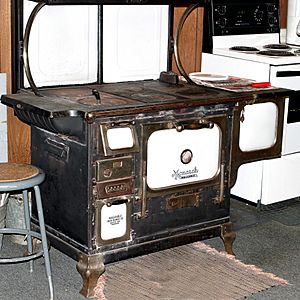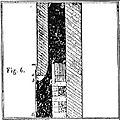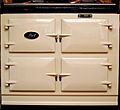Kitchen stove facts for kids
A kitchen stove is a special machine used for cooking food. People often just call it a stove or a cooker. Stoves cook food by using direct heat. Many stoves also have an oven built in, which is used for baking.
There are different kinds of stoves. "Cookstoves" (also called "cooking stoves" or "wood stoves") burn wood or charcoal to create heat. "Gas stoves" use gas, and "electric stoves" use electricity. If a stove has a cooking surface on top, it's also called a range.
Long ago, people cooked over open fires. Then, stoves were invented to be more efficient and reliable. At first, stoves heated homes and cooked food. But as homes got central heating systems, people started using separate cookers just for cooking. The words cooker and stove are often used to mean the same thing.
About half the people in the world, especially in developing countries, still cook their food using basic cook-stoves or open fires. They burn things like wood, charcoal, or plant waste. Newer, more fuel-efficient stoves are being made to help these communities.
In many Western countries today, gas and electric stoves are the most common. Both types work well and are safe. Choosing between them often depends on what kind of connections a house already has. For example, adding a gas line can be expensive if a house doesn't have one.
Modern kitchen stoves usually have a flat "stove-top" or "cooktop" for pots and pans, plus an oven below. A "drop-in range" is a stove and oven together that fits neatly into kitchen cabinets. Many new stoves also come with built-in extractor hoods to pull smoke and smells away.
Some professional chefs prefer gas stovetops. This is because gas lets them control the heat very quickly and precisely. Today, most big brands offer both gas and electric stoves. Many also sell "dual-fuel" ranges, which have a gas stove-top and an electric oven.
The History of Kitchen Stoves
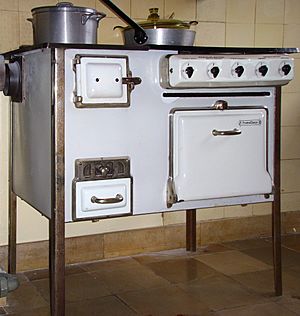
The idea for the modern kitchen range came from Sir Benjamin Thompson, also known as Count Rumford. He was a scientist and inventor in the 1790s. He studied how heat works and improved fireplaces and furnaces. This led him to invent the kitchen range we know today.
The first gas stove was shown in London at The Great Exhibition in 1851. But it took until the 1880s for gas stoves to become popular in England. By then, a good network of gas pipeline transport had spread across the country. This made gas cheap and easy to use in homes. Gas stoves became common in Europe and the United States in the early 1900s.
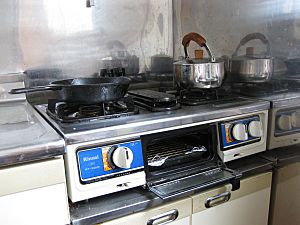
Once electricity became widely available and affordable, electric stoves became another choice. A Canadian inventor named Thomas Ahearn patented one of the first electric stoves in 1892. An electric kitchen was even shown at the Chicago World's Fair in 1893.
Electric stoves took longer to become popular than gas stoves. People weren't used to the new technology, and many towns didn't have electricity yet. Early electric stoves also had problems: electricity was expensive, they didn't get very hot, and their heating parts didn't last long. Things got better when nichrome alloy was invented for heating wires. This made electric stoves cheaper and more durable.
The first practical electric stove design was patented by David Curle Smith in Australia in 1905. His design is similar to most electric stoves today: an oven with a hotplate on top and a grill tray in between.
Later, Microwave ovens were developed in the 1940s. These ovens use microwave radiation to heat the water inside food very quickly.
Images for kids
-
An Indonesian traditional brick stove, used in some rural areas
-
Section of a Rumford fireplace, invented by Sir Benjamin Thompson.
-
Early gas stoves produced by Windsor in Mrs Beeton's Book of Household Management, 1904.
See also
 In Spanish: Cocina (artefacto) para niños
In Spanish: Cocina (artefacto) para niños


